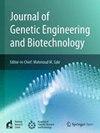Cloning and functional analysis of the TERE1 gene using the Gal4-UaS system in S2 cells: A streamlined approach for human gene functional genomics
IF 2.8
Q3 Biochemistry, Genetics and Molecular Biology
Journal of Genetic Engineering and Biotechnology
Pub Date : 2025-06-28
DOI:10.1016/j.jgeb.2025.100525
引用次数: 0
Abstract
The post-genome sequencing era faces the challenge of understanding gene functions. While model organisms and mutagenesis screens are helpful, they can be labor-intensive. This study demonstrates a streamlined gene cloning approach using the human TERE1 gene and the pUAST vector system for expression in Drosophila S2 cells. The pUAST vector was employed to clone the TERE1 gene and insert it into S2 cells, allowing co-transfection with multiple constructs for co-expression of up to four proteins. This provided a stable and selectable platform. The cloning of TERE1 in PcDNA3.1 and pUAST vectors confirmed the expression of TERE1 protein alongside EGFP. The expressed TERE1 protein in Drosophila melanogaster (D.m) Schneider recombinants resembled the normal Drosophila HEIX1 protein, which is critical in the larval-to-adult transformation as proved by western blot. The pUAST system proved effective for TERE1 gene cloning and the simultaneous expression of multiple proteins. This simplified method presents an efficient alternative to traditional mutagenesis screens, facilitating gene function studies and aiding the identification of disease-related genes.
利用Gal4-UaS系统克隆S2细胞TERE1基因及其功能分析:人类基因功能基因组学的一种简化方法
后基因组测序时代面临着理解基因功能的挑战。虽然模式生物和诱变筛查是有帮助的,但它们可能是劳动密集型的。本研究展示了一种利用人类TERE1基因和pUAST载体系统在果蝇S2细胞中表达的流线型基因克隆方法。利用pUAST载体克隆TERE1基因并将其插入S2细胞中,允许与多个构建体共转染,共表达多达四种蛋白。这提供了一个稳定和可选择的平台。TERE1在PcDNA3.1和pUAST载体上的克隆证实了TERE1蛋白与EGFP的表达。在黑胃果蝇Schneider重组体中表达的TERE1蛋白与正常果蝇的HEIX1蛋白相似,经western blot证实,TERE1蛋白在果蝇幼虫向成虫转化过程中起关键作用。该系统被证明是TERE1基因克隆和多种蛋白同时表达的有效方法。这种简化的方法为传统的诱变筛选提供了一种有效的替代方法,有助于基因功能的研究和疾病相关基因的鉴定。
本文章由计算机程序翻译,如有差异,请以英文原文为准。
求助全文
约1分钟内获得全文
求助全文
来源期刊

Journal of Genetic Engineering and Biotechnology
Biochemistry, Genetics and Molecular Biology-Biotechnology
CiteScore
5.70
自引率
5.70%
发文量
159
审稿时长
16 weeks
期刊介绍:
Journal of genetic engineering and biotechnology is devoted to rapid publication of full-length research papers that leads to significant contribution in advancing knowledge in genetic engineering and biotechnology and provide novel perspectives in this research area. JGEB includes all major themes related to genetic engineering and recombinant DNA. The area of interest of JGEB includes but not restricted to: •Plant genetics •Animal genetics •Bacterial enzymes •Agricultural Biotechnology, •Biochemistry, •Biophysics, •Bioinformatics, •Environmental Biotechnology, •Industrial Biotechnology, •Microbial biotechnology, •Medical Biotechnology, •Bioenergy, Biosafety, •Biosecurity, •Bioethics, •GMOS, •Genomic, •Proteomic JGEB accepts
 求助内容:
求助内容: 应助结果提醒方式:
应助结果提醒方式:


